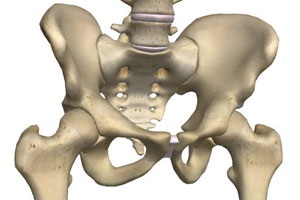How Your Hip May be Causing Pain in Your Knees and Back and What to Do to Stop it
 Have you ever experienced pain in your back or knees? It could be because of your hip joints.
Have you ever experienced pain in your back or knees? It could be because of your hip joints.
The joint that links your pelvis (a strong support structure on which your spine sits) to your legs is known as the hip joint.
Your hip joint is a synovial ball-and-socket joint which means it is made up of a round ball portion at one end of the thigh bone and the domed socket portion of your pelvic bone.
This anatomy is what allows great freedom of movement of your hip joint. It allows you to stand straight upright while still giving you the ability to bend, kick, run, jump and just be very mobile.
On the other side of it, because your hips are made up of this ball-and-socket construction, they are also very vulnerable to too much movement which can lead to shifting and pinching and eventual wearing down of the joint, injury and pain. This vulnerability along with its central location to affecting many other areas of your body can make the hip joint quite the bully when it’s not working well.
More stable joints like the elbow or knee, which are hinge joints, only allow a joint to move primarily one direction. And while they can affect bones and joints nearby, they do not do this to the extent the hip joint does.
Believe it or not, because of the great amount of mobility in the hip, you can sometimes acquire injury and pain in your hip, knees and back just from sitting too long.
To understand how this happens, you need to realize how the hip joint is given strength. To stabilize the hip joint, you have strong muscles surrounding and aiding it for movement. They work to give the hips strength and stability and provide you with the motion you love. However, when these muscles are kept in a shortened or tightened position too long, with prolonged sitting for instance, they may stay that way when you get up too.
This means powerful muscles are pulling tightly on the hip joints even though you’ve stood up and started walking around and they should be at a more lengthened and relaxed position.
One of these big powerful muscles is called your iliopsoas muscle. It attaches by your spine – or your back bones and at your thigh bone (the femur). It works to raise your leg forward and rotate it outward. When it stays too tight because of prolonged sitting, it can pull the ball of the thigh bone forward in the domed socket and can pinch the hip joint, leading to pain.
Additionally, this tight muscle may pull tight and steady enough that it causes you to walk bent forward. When you’re bent forward, you have gravity working against you on most areas of your body which puts more stress on your whole spine all the way to your neck. This may also cause painful pinching of the joints in your back.
And if all that doesn’t seem harmful to your body, well-being and ability to move at your best…additionally, if your iliopsoas muscles are left tight and shortened, they can put more stress on your knees because they rotate your legs outward. Walking with a slight outward rotation in your knees can cause the knee joint to be off balance, not work well and eventually lead to abnormal wear and tear and pain in your knees.
As you can see, a small imbalance just from the hip muscles can lead to bigger problems in other areas of your body if they are not taken care of. But a bully can only stay a bully if left unchecked. Make sure you pay attention to your body and if you’d like an experienced opinion about what’s happening with your hips, back, or knees, we’ve helped hundreds overcome pain that holds them back from moving and feeling their best.